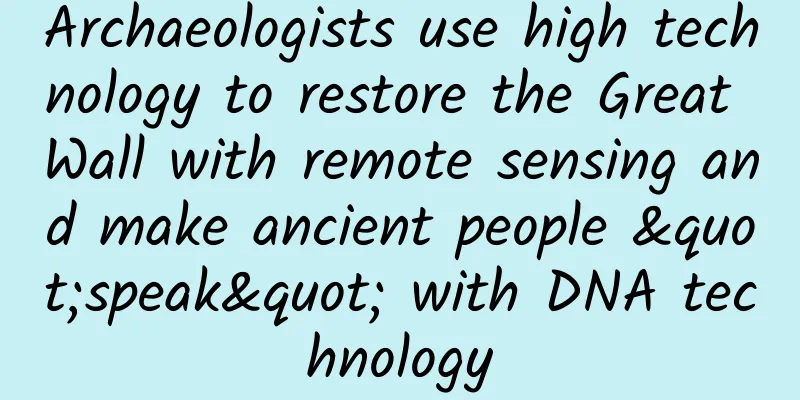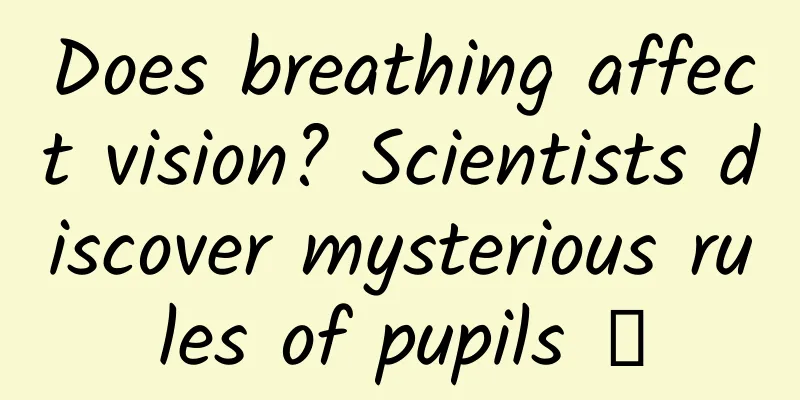Archaeologists use high technology to restore the Great Wall with remote sensing and make ancient people "speak" with DNA technology

|
Produced by: Science Popularization China Author: Chen Dian (University of Chinese Academy of Sciences) Producer: China Science Expo In the mist of history, archaeology is like a searchlight, shining a faint light on the vague outlines of ancient ruins and mysterious civilizations. The road of archaeology used to be like a wilderness, with explorers relying on shovels and notebooks, constantly sweating on ancient sites, and discovering clues of the past bit by bit. A shovel, a brush, a microscope... Tools used in archaeological excavations (Image source: Veer Gallery) Today, the rapid development of science and technology has given archaeology the wings to take off. Scientific and technological archaeology is like a huge toolbox filled with various cutting-edge technologies - computer simulation and reconstruction, biological gene analysis, physical spectrum detection, chemical material analysis, geological stratigraphic research... These magical skills are like magic that can travel through time and space, allowing us to feel the pulse of ancient times and gain a deeper understanding of the living conditions of our ancestors. Remote sensing archaeology: A "God's perspective" overlooking ancient monuments from high altitude China's vast land has nurtured a long history and culture, with a large number of cultural relics and historical sites scattered across the country. From large ancient settlements to ancient cities, imperial tombs, the Great Wall, the Silk Road, etc., these precious sites constitute our rich and colorful history and culture, and at the same time carry the memory of human history. However, with the passage of time and changes in the environment, the appearance of these relics has become increasingly blurred. At this time, remote sensing archaeology came onto the stage. Remote sensing archaeology, in short, is a method of remotely observing and detecting surface and underground relics using sensors such as electromagnetic waves . This technology allows us to have a "God's perspective", capturing not only beautiful scenery, but also treasures hidden under the surface. Aerial view of the Liangzhu ancient city ruins (Photo source: State Administration of Cultural Heritage official website) By analyzing satellite images or photos taken by drones, combined with data such as surface features and spectral imaging, we can determine the location, distribution, size, shape, and even the characteristics of the surrounding environment of the site. In addition, remote sensing technology can also track changes on the surface , helping us understand the protection status of ancient sites and formulate better protection measures. Remote sensing interpretation of the Guazhou-Shazhou section of the Silk Road (Photo source: Chinese Academy of Sciences) Of course, natural factors on the surface, such as vegetation and topography, can interfere with the interpretation of remote sensing images, adding to the challenge. Therefore, it is often necessary to combine remote sensing technology with other technologies to ensure the accuracy and completeness of the findings. For example, the Great Wall, an ancient and majestic structure, has suffered from the erosion of time and human destruction. However, with the help of remote sensing technology, we have the opportunity to discover its remains hidden between the desert and mountains, and overlook its extended paths and veins, so as to better protect and understand this ancient history. "Restoring" the ancient Great Wall of Xinjiang with the help of remote sensing technology (Photo source: Chinese Academy of Sciences) Whether it is the Grand Canal stretching for nearly 2,000 kilometers, or the capital city ruins such as Liangzhu, Taosi, and Erlitou sleeping underground, or the ancient countries buried on the Silk Road of the past, they are gradually being presented to us again in an intuitive and vivid way through remote sensing archaeology. Dating: Cracking the Code of Time Imagine that you are an archaeologist, standing in front of an ancient site, thinking about the stories behind the relics. There are traces of ancient humans buried here, but you are faced with a difficult question: which period do these relics belong to? In the past, archaeologists used similarities to estimate the age of artifacts. Like a jigsaw puzzle, you would compare artifacts from different locations, looking for similarities, and then use those similarities to determine whether they were from the same era. However, this approach can sometimes be confusing. Some artifacts, while similar, may be from different eras, leaving your research full of guesswork and uncertainty. With the advancement of science and technology, modern archaeological dating technology has opened a window into the past for us. Radioactive isotope dating is one of the important technologies, and the most well-known one is carbon 14 dating . Carbon 14 dating is mainly based on the decay cycle of carbon elements, measuring the decay degree of carbon in the material to estimate the decay time. The more accurate the measurement of carbon atoms, the more accurate the time judgment. This technology is suitable for dating within tens of thousands of years, and provides a powerful tool for studying the Paleolithic Age, the Neolithic Age, etc. Commonly used samples for carbon 14 dating (Photo credit: Institute of Archaeology, Chinese Academy of Social Sciences) In addition, tree ring dating is also an important technique for determining the age in archaeological research. Its principle is very simple. By analyzing and studying the tree rings in a specific climate zone and establishing a chronology of long-sequence tree rings, it is possible to accurately date wooden relics of the same tree species unearthed in archaeological sites in this area. In addition, thermoluminescence dating and paleomagnetic dating also provide archaeologists with a variety of dating methods. For example, thermoluminescence dating is suitable for the accumulation of mineral particles under long-term light exposure, and can be used to determine the age of sediments; paleomagnetic dating determines the age of soil minerals by studying the fossil magnetism of soil minerals. OSL dating sampling (Photo credit: Institute of Archaeology, Chinese Academy of Social Sciences) With dating data, we can reveal the true age of cultural relics and sites, and draw clear lines of time between different cultures and events. We can even connect relics from different locations according to chronological sequences to depict richer details of ancient cultural exchanges and changes. Ancient DNA research: Listen, the remains can "speak" Who are we and where do we come from? People used to use myths to explain their origins. With the rapid development of modern DNA technology, scientists have found a new way to explore and solve the mystery of human origins. Scientists extracted DNA from ancient remains , which is like awakening the genes of the ancients and bringing them back to life. By comparing the genetic information of modern people and ancient people, we can restore the family relationships of the ancients bit by bit. We can know whether the ancients are related, whether they belong to the same family, and even trace the migration history of ancient humans. Ancient DNA experimental process (Image source: Chinese Academy of Sciences) For example, when scientists studied ancient DNA from Neanderthals, they unexpectedly discovered that Neanderthals and modern humans actually shared some of the same gene fragments. These common genes may have once helped humans adapt to cold environments. What is even more surprising is that through in-depth analysis of the ancient DNA of African people, scientists have successfully confirmed an ancient legend: the origin of modern humans is Africa. Ancient DNA can also reveal the evolution and divergence of language . As different groups separated, their languages gradually changed and diverged into different dialects and languages. By analyzing the genomes of ancient humans, scientists can track the history of these language changes . For example, one study found that the changes in the genomes of ancient humans in different regions of Europe were closely related to the distribution of language families, which revealed the trajectory of ancient human language evolution. The Institute of Vertebrate Paleontology and Paleoanthropology of the Chinese Academy of Sciences and its cooperative team conducted archaeological excavations, and ancient DNA research revealed the evolutionary history of the Qinghai-Tibet Plateau population over the past 5,100 years. (Image source: Chinese Academy of Sciences) However, ancient DNA research is not without challenges. The DNA in ancient remains has usually been eroded by time and may have been broken down to a very small amount. Scientists need to look for clues in extremely small DNA fragments, which is as difficult as looking for a needle in a haystack. They need to use advanced technology and patiently reconstruct the genetic sequences of ancient people in order to restore their stories. Residue analysis: Unfolding the picture of ancient civilization from the details In their various production activities, the ancients often inadvertently left behind some tiny and fragmentary traces. Past archaeological studies have often failed to delve into these details. The organic matter that remains from the process of our ancestors processing and utilizing biological resources is collectively called organic residues . Organic residues can be divided into two types: one is visible to the naked eye , such as liquids and carbonized materials; the other is trace residues that are too tiny to be directly observed, including lipids adsorbed on pottery fragments, tartaric acid, resin acid, and even plant microfossils such as phytoliths and starch grains. Although visible residues are relatively rare in archaeological excavations, trace residues are widely present on ancient stone tools, pottery and bronze artifacts, and have become the main research object of organic residue analysis. A miniature copper box and the remains inside it unearthed from the Beibai'e Cemetery in Yuanqu (Photo source: Shanxi Provincial Institute of Archaeology) Scientists can get a glimpse into ancient people's eating habits, food processing techniques , etc. through the analysis of organic residues. For example, food residues extracted from ancient pottery fragments can reveal the dietary structure and preferences of ancient people, and even infer ancient recipes. In addition, organic residues in plant and animal remains and relics also provide important clues for studying the origin and spread of agriculture. By analyzing the genetic information and organic matter of crops, we can reveal the origin of agriculture, its diffusion path, and the evolution of agricultural technology. At the same time, organic residue analysis is also helpful in studying the development of ancient handicrafts. Organic molecules extracted from ancient artifacts can reveal the rise and fall of ancient textile, medicine, cosmetics and other industries. By analyzing organic residues in ruins, we can understand how ancient people extracted raw materials from nature and how they processed them into products for various purposes, thereby revealing the technical level of ancient handicrafts. Researchers took samples on site and conducted scientific analysis (Image source: The Paper) Conclusion As the name "technological archaeology" suggests, technology has become an indispensable means of archaeological research, allowing us to uncover the veil of the past and touch the traces of the ancients. With the continuous advancement of technology, we have reason to believe that future scientific and technological archaeology will bring us more surprises and discoveries. Whether it is restoring magnificent ruins or exploring tiny relics, every scientific and technological archaeology is a solid step towards solving historical mysteries. Under the guidance of science and technology, archaeology has built a bridge that carries historical memory, allowing us to have a deeper understanding of human past and providing unlimited possibilities for future research. |
>>: No kidding! Xinjiang really produces seafood!
Recommend
Why do black truffles taste like gasoline?
There are always some ingredients that are out of...
Live streaming was extremely popular in 2016, what will be the highlight in 2017?
Live streaming itself is a very "lively"...
Eight technologies that mobile developers cannot ignore
In recent years, the influence of programmers, es...
It’s scary to think about it! This is how your privacy is sold...
Source: Dr. Curious This article has been authori...
It’s quiet now. Alipay has cracked down on pop-up ads, reducing them by 70%.
[[406905]] As a national-level APP, Alipay has br...
Gamma Data: Development Prospects of AIGC in China’s Game Industry in 2023
AIGC Industry Development Background AI will beco...
A large amount of metal was found in an ancient Roman shipwreck, and archaeologists and physicists are fighting over it...
In 1988, about 10 kilometers off the coast of Sar...
5-day learning plan of ancient beauty exercises, 5 minutes a day to remove wrinkles, lighten spots and fight aging
Every woman wants to be younger than her peers Sk...
The Journey to Psyche Exploration Begins! The Target is More Than Just the "Golden Planet"
At 22:19 Beijing time on October 13, the US Falco...
How to formulate a brand strategy? The Four Elements of Brand Strategy
Nowadays, with the continuous development of soci...
Future Market Insights: Global car rental market valued at $116 billion in 2019
According to Future Market Insights, although Nor...
Analysis of "background invalid animation" behavior in Android
When an Android App is put into the background, a...
Dealers frequently go bankrupt, thousands of dealers have withdrawn from the network in five years, and 4S stores finally fell into their own "pig-killing plate"
Chinese netizens often come up with some brillian...
Behind the touching story, how does Jiang Xiaobai think about its brand strategy?
Jiang Xiaobai CMO Ye Ming told the Camp Creation ...









